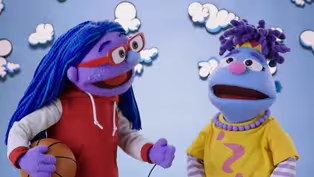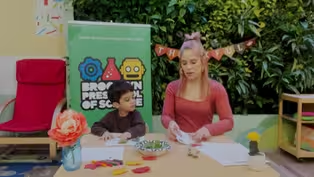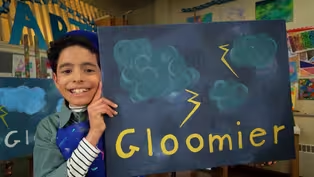
EXTREME EATERS: GORILLAS
Clip: 7/16/2024 | 3m 27sVideo has Audio Description, Closed Captions
Meet gorillas who live at the Houston Zoo, where they eat fruit and leafy greens.
Meet gorillas who live at the Houston Zoo, where they eat fruit and leafy greens. They are very intelligent, and can make up to 25 vocalizations – grunts, laughs, hoots, barks, and screams. Each has a specific meaning.
See all videos with Audio DescriptionADProblems playing video? | Closed Captioning Feedback
Problems playing video? | Closed Captioning Feedback
Let's Learn is a local public television program presented by THIRTEEN PBS

EXTREME EATERS: GORILLAS
Clip: 7/16/2024 | 3m 27sVideo has Audio Description, Closed Captions
Meet gorillas who live at the Houston Zoo, where they eat fruit and leafy greens. They are very intelligent, and can make up to 25 vocalizations – grunts, laughs, hoots, barks, and screams. Each has a specific meaning.
See all videos with Audio DescriptionADProblems playing video? | Closed Captioning Feedback
How to Watch Let's Learn
Let's Learn is available to stream on pbs.org and the free PBS App, available on iPhone, Apple TV, Android TV, Android smartphones, Amazon Fire TV, Amazon Fire Tablet, Roku, Samsung Smart TV, and Vizio.
Providing Support for PBS.org
Learn Moreabout PBS online sponsorship[bright music] [whimsical music] - [Narrator] Western lowland gorillas are native to Central Africa, though our gorillas were all born and raised in other American zoos.
Gorillas are the largest of the living apes, although the western gorilla is smaller and lighter than its eastern, or Grauer's, gorilla relative.
They live in structured family groups containing a dominant male, several females, and their offspring.
Mature male gorillas are known as silverbacks, and are named after the silvery white hair on their back, rump, and thighs.
Silverbacks form bachelor groups after leaving their family and before taking over or forming a new group.
Here in Houston, two troops call the zoo home, one family group and one bachelor group.
Gorillas inhabit a variety of forests, as well as lowland areas in their native habitat.
Their diet is mainly fruit and vegetation.
This means they are frugivores.
Unlike herbivores, whose diets rely solely on plants, frugivores enjoy diets consisting of primarily fruits, as well as leafy greens, nuts, and seeds.
Gorillas are also very intelligent animals and have been seen using tools.
They're quite capable of doing complex tasks.
They can make up to 25 vocalizations, such as grunts, laughs, hoots, barks, and screams, each with its own specific meaning.
Adults perform elaborate displays, including chest beating, running sideways, and tearing up vegetation, to frighten off an intruding male or other threat.
Mike is a perfect example of this.
Mike loves to act tough, but secretly has the sweetest, most playful personality.
His favorite thing is to charge and display at new people, and then watch their reactions from the corner of his eye.
Although they can walk for short distances on two legs, usually in conjunction with doing a display, gorillas generally get around by walking on all fours.
When doing this, they walk on their knuckles, which is known as knuckle walking.
In the wild, the endangered western lowland gorilla faces many threats.
Their native habitat in Central and West Africa is shrinking, largely due to the expansion of mining and agriculture in the area.
In the rainforest homes of animals like gorillas, chimpanzees, and okapi, there's a metal called tantalum that we use in electronics like our laptops and cell phones.
If we recycle our small electronics, the materials taken from wildlife habitats can be reused, allowing those habitats to be protected.
CHEYENNE TEACHES A TWO FOOT GLIDE!
Video has Audio Description, Closed Captions
Clip: 7/16/2024 | 42s | Cheyenne from Figure Skating in Harlem teaches a two-foot glide! (42s)
Video has Audio Description, Closed Captions
Clip: 7/16/2024 | 7m 8s | Mix yellow and blue to make green and paint a plant. (7m 8s)
FEEL YOUR BEST SELF: SMELL THE ROSES
Video has Audio Description, Closed Captions
Clip: 7/16/2024 | 3m 41s | Learn a strategy called “Smell the Roses” to refocus. (3m 41s)
Video has Audio Description, Closed Captions
Clip: 7/16/2024 | 6m 42s | Make rubbings using leaves and crayons with Krystal Balmes from the Brooklyn Preschool of Science. (6m 42s)
Video has Audio Description, Closed Captions
Clip: 7/16/2024 | 5m 11s | Play a number flash game with Zoe Kleinmann. (5m 11s)
Video has Audio Description, Closed Captions
Clip: 7/16/2024 | 4m 52s | See how to make a soothing tea recipe from the 18th century for coughs and sore throats. (4m 52s)
UP IN THE GARDEN AND DOWN IN THE DIRT
Video has Audio Description, Closed Captions
Clip: 7/16/2024 | 6m 35s | Anna Scretching-Cole reads UP IN THE GARDEN AND DOWN IN THE DIRT by Kate Messner. (6m 35s)
UP IN THE GARDEN AND DOWN IN THE DIRT ASL
Video has Audio Description, Closed Captions
Clip: 7/16/2024 | 6m 36s | Anna Scretching-Cole reads UP IN THE GARDEN AND DOWN IN THE DIRT by Kate Messner. (6m 36s)
WORDSVILLE: THE CASE OF TOO MUCH HAPPY
Video has Audio Description, Closed Captions
Clip: 7/16/2024 | 7m 26s | When Artist Clay's gloomy painting goes missing, everyone in Wordsville is overjoyed. (7m 26s)
Providing Support for PBS.org
Learn Moreabout PBS online sponsorshipSupport for PBS provided by:
Let's Learn is a local public television program presented by THIRTEEN PBS
























